
Dinosaur & Paleontology Sites
This page is one small part of Good Sites for Kids!
Part of the Science and Nature section.
Look
for ![]() to
see what's been added lately!
to
see what's been added lately!

![]()
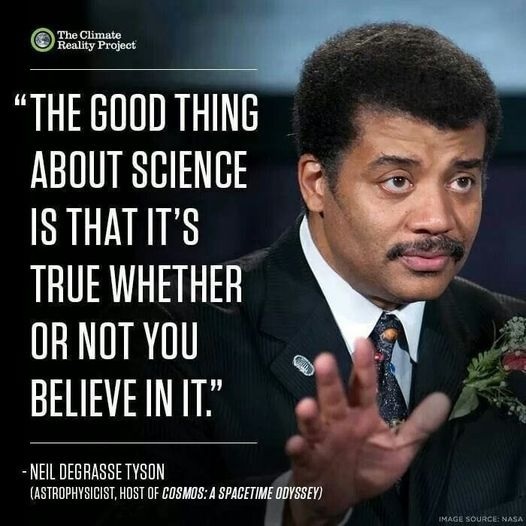

![]()
Giant prehistoric Crocodilians!
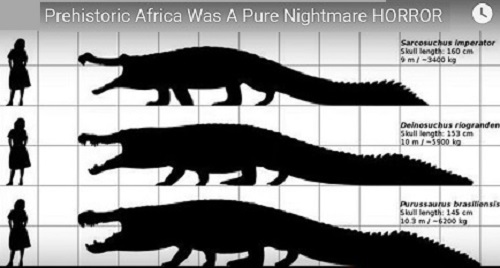
44,000-year-old
wolf found
Kinda freeze-dried
Includes a video about the discovery of
a frozen baby wolf cub in the Yukon
(with big ol' puppy paws)
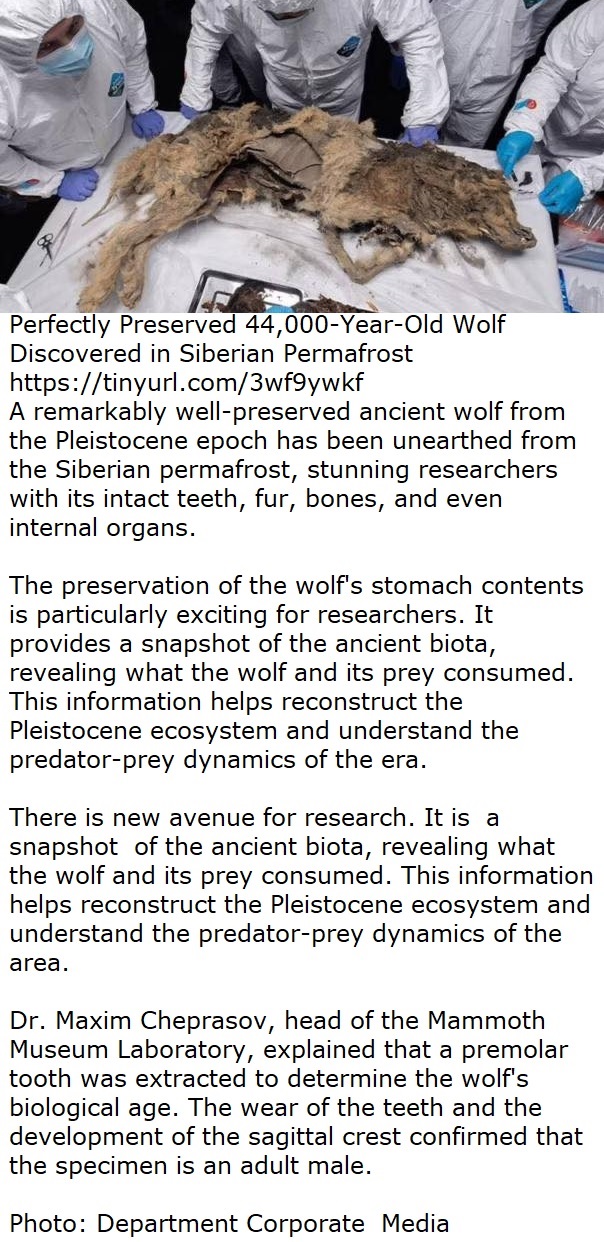
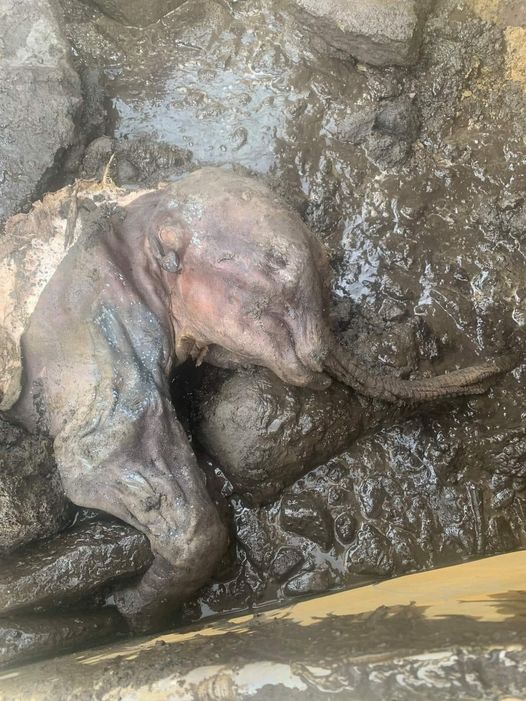
credit: Joshua Rojas in The
Phanerozoic Eon
"A new discovery was announced today. Darwin's beard! Is all I
can say to the most complete mummified woolly mammoth ever
found in North America. My jaw is just dropping to the remarkable
preservation of this calf, it is just amazing! It was found on
June 21, 2022 in the Klondike gold fields, Yukon, Canada.
Photograph by Willem Middelkoop"
40,000-year-old
wolf's head preserved by permafrost found in Siberia

June 14, 2019 / 3:54 PM / CBS News
A 40,000-year-old wolf's head was discovered in northern Russia
—
with its ears, fangs, brain and tongue perfectly intact in the permafrost.
Scientists believe the beast from the Ice Age belonged to a now-extinct
subspecies of wolf that lived during the same era as mammoths.
The furry head of the wolf was found in the Russian Arctic region
of Yakutia
last summer, according to a Russian newspaper, The Siberian Times.
The wolf's head is about 40 centimeters (almost 16 inches) long, and the
wolf was estimated to be between the ages of 2 and 4 when it died.
"This is a unique discovery of the first ever remains of
a fully grown
Pleistocene wolf with its tissue preserved," Albert Protopopov, a top
researcher at the Russian Academy of Sciences, told the newspaper.
Ages of Earth mug
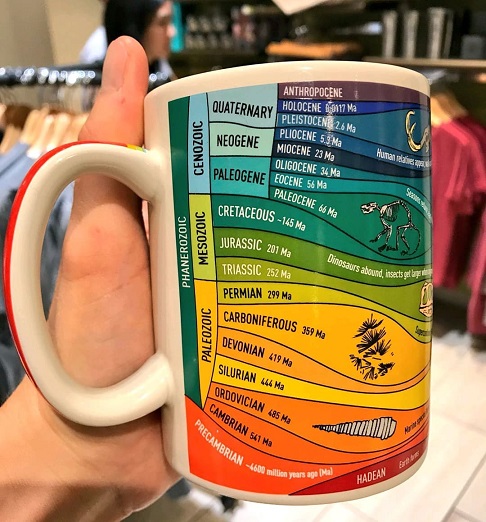
The Age
of Reptiles in 3 Acts 10:30 video covers the entire Mesozoic!
Begins in the Permian, covers Triassic, Jurassic, & Cretaceous. Very detailed
descriptions and explanations. "Reptiles emerged from the Paleozoic as
humble
creatures, but in time, they grew to become some of the largest forms of life
ever to stomp, swim, and soar across the planet. This Age of Reptiles was
a
spectacular prehistoric epic, and it all took place in a single era: the Mesozoic.
From Eons (BIG collection of videos) and PBS.
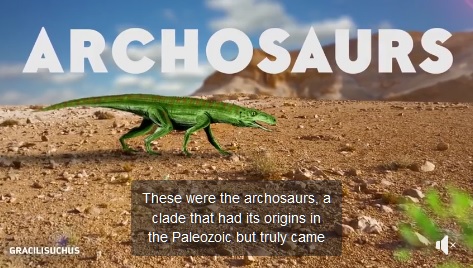
![]() Alligators and
Crocodiles at Enchanted LearningGiving
crocodilians their usual epic treatment - Poems, art with facts to color,
report worksheets, graphic organizers, report wheels, and more. Editorial:
if you don't already subscribe to Enchanted Learning, you really should.
Alligators and
Crocodiles at Enchanted LearningGiving
crocodilians their usual epic treatment - Poems, art with facts to color,
report worksheets, graphic organizers, report wheels, and more. Editorial:
if you don't already subscribe to Enchanted Learning, you really should.
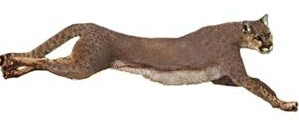 American Cheetah
was probably the reason why pronghorns
run so fast!
American Cheetah
was probably the reason why pronghorns
run so fast!
Find out more about this extinct cougar relative at Dinopedia,
"The wiki
about all prehistoric life", which had close to 1,200 pages of animals
like
this one, and almost 3,000 pictures like this one!
"Speed" by
Velizar
Simeonovski
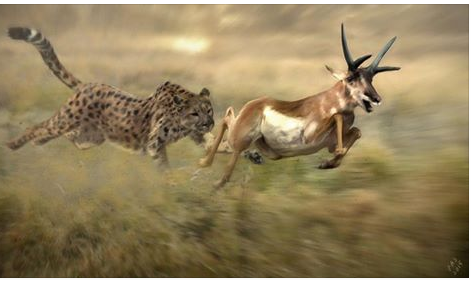
Includes a good technical article (with Ed Welsh) explaining
this as an example of convergent
evolution.
Our "cheetahmorph" here is actually related to mountain lions,
not to living cheetahs. Just because two animals or plants
look uncannily alike, doesn't mean they're closely related.
There's also a good bibliography.
American lion
This huge beast of prey was a (very) close relative of the Cave Lion of Europe
and Asia. How closely related the two of them were to African lions is still
being debated. Click to read the Wikipedia
article and the Dino
Animals article. Click here
and here
for two awesome paintings. American Lion's remains are found with those of animals
that lived on plains and tundra, so they must have been plains animals.
This is the fossil of a "medium sized" ammonite.
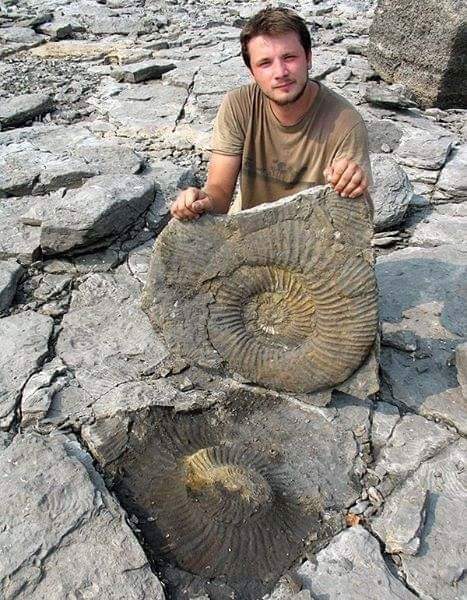
"The fossils are loved by everyone. I do not know why!!!
But the form of the beautiful and mysterious old makes it a
destination for everyone. A fossil is evidence or trace of a
dead animal or plant. Footprints imprinted on rocks,
bones of ancient humans and animals, shells, etc.
Fossils can be very large or very small. Microfossils are only
visible with a microscope. Bacteria and pollen can be
microfossils.
Macrofossils can be several meters long and weigh several
tons. Macrofossils can be petrified trees or dinosaur bones.
Preserved remains become fossils if they reach an age of
about 10,000 years. Fossils can come from the Archaeaean
Eon (which began almost 4 billion years ago) all the way
up to the Holocene Epoch (which continues today).
The fossilized teeth of wooly mammoths are some of our
most "recent" fossils. Some of the oldest fossils are those
of ancient algae that lived in the ocean more than 3 billion
years ago." From the #Geology Here FB page.
below: a huge ammonite (top),
small ammonites (bottom)
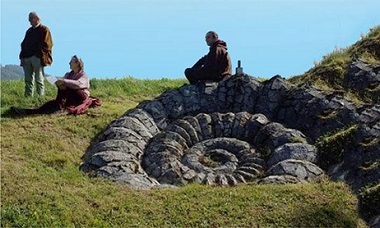
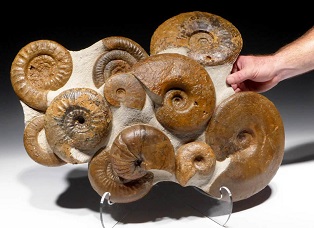
Ancestor of all animals identified in Australian fossils "It says
here."
More accurately, the oldest animal showing bilateral symmetry.
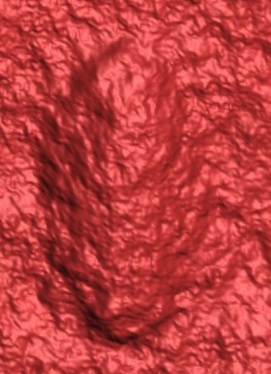
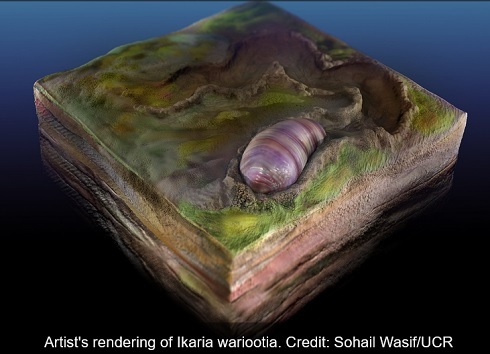
A stand-alone site that complements the
Dinosaur Pictures and Facts site.
The
totally unrelated site Our Planet
liked
it so much that they expanded on it
and explained it in more depth!
What did Ancient Earth Look Like
"I stumbled upon an amazing web page showing
what did ancient Earth look like. On the “Dinosaur
Pictures and Facts” web page (dinosaurpictures.org),
there’s also an interactive animation. On this page,
you can either select the years (i.e. 600 million years
ago) or jump to a particular event (i.e. first
multicellular life) and see how ancient Earth
looked like then. You can also remove the clouds
and stop the Earth’s rotation if you want to.
![]()
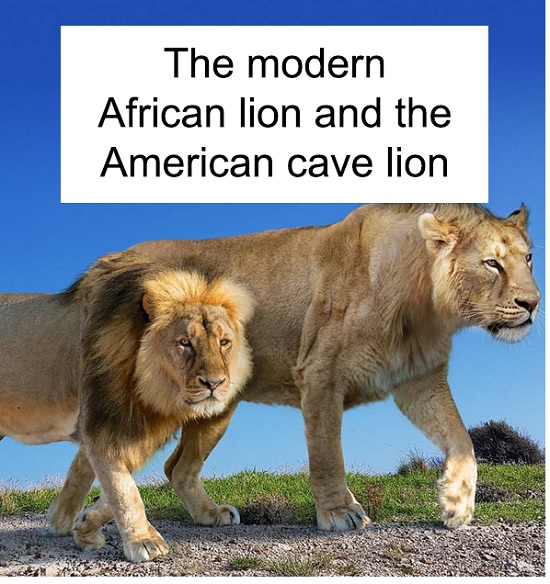
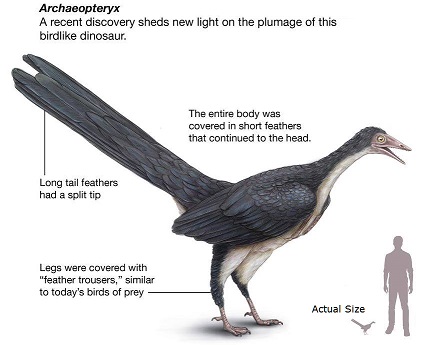
Archosaurs is about dinosaurs, crocodiles, birds, and all their diapsid relatives, both living and extinct. Part of UC Berkeley's gigantic tree of life web site complex. This is for older kids. Diapsids = all birds and living reptiles except turtles. Turtles are the only living anapsids. We mammals are synapsids. It all has to do with the number of holes in the skulls.
Stone carving of a bull aurochs from Grotta
del Romito, southern Italy.
Aurochs are the ancestors
of modern cattle. Big as an American bison,
aurochs had distinctive curved horns.
Black bulls and brown cows.
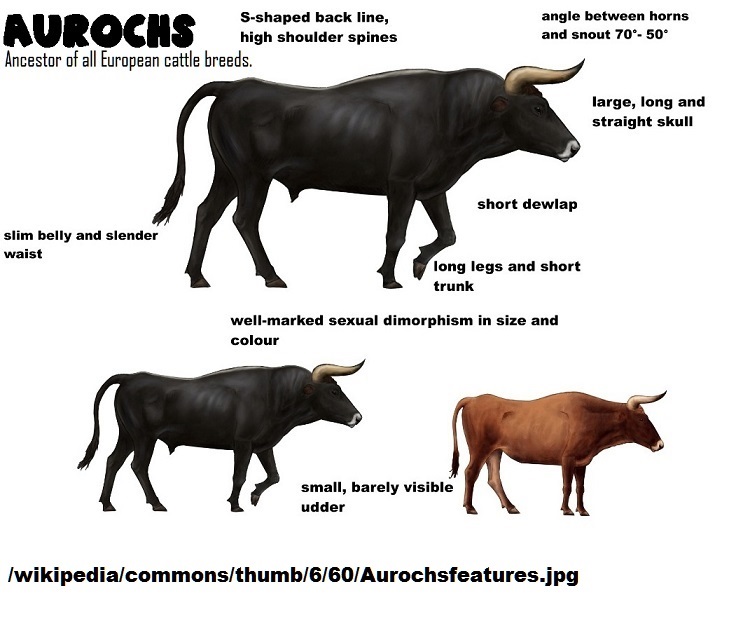
Julius Caesar described aurochs herds he saw
in Gaul (ancient France).
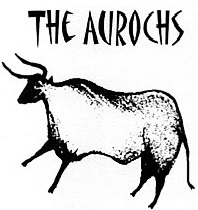
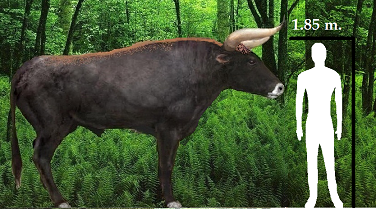
Big Al
game #2 - The saga continues!
Thanks to Jennifer Edwards.
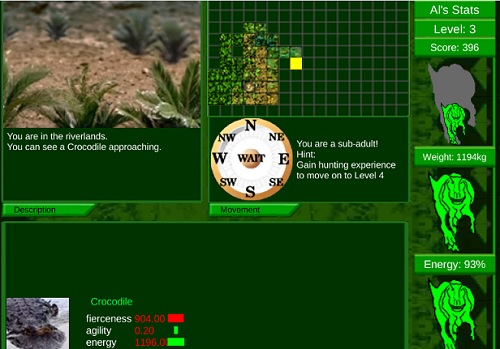
"Unity 2D recreation of a 1990s BBC browser game.
In the game the user plays the dinosaur 'Big Al', moving
around a map, trying to survive and grow to achieve a
high score. Enemies attack or flee in realtime, and the
player's energy drops over time."
Play it online
or download
it.
 Black Hills Institute of Geological Research has a fantastic
dinosaur museum in Hill City. Small in area but crammed with dino skeletons
including (usually) several T-Rex. Known worldwide, the Institute sponsored
the 100 Years of T-Rex seminar in the summer of 2005, with many big names
in paleo attending. For even more dinos and critters check out the Geology
Museum at the South Dakota School of Mines and Technology.
Black Hills Institute of Geological Research has a fantastic
dinosaur museum in Hill City. Small in area but crammed with dino skeletons
including (usually) several T-Rex. Known worldwide, the Institute sponsored
the 100 Years of T-Rex seminar in the summer of 2005, with many big names
in paleo attending. For even more dinos and critters check out the Geology
Museum at the South Dakota School of Mines and Technology.
Cambrian
Explosion is a 46-second Facebook video from @Paleozoo Australia.
It features several of the Burgess Scale animals doing animated things. A
surprise ending, so keep watching!
Beautiful fossil fern from the Carboniferous
era.
Donetsk region, eastern Ukraine
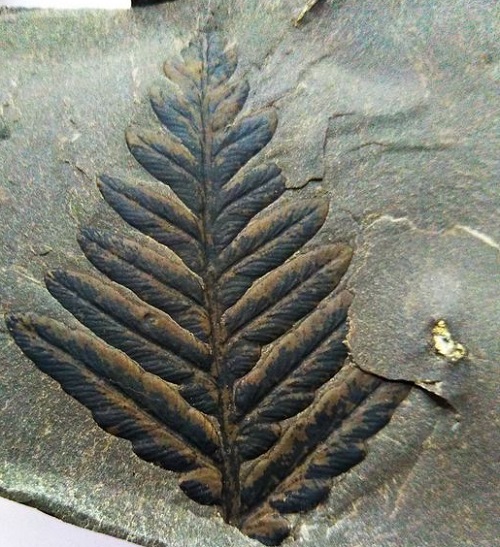
More detail about the Carboniferous
.jpg) Chauvet-Pont-d'Arc
Cave This French cave is a UNESCO World Heritage site. Discovered
in 1994, it's famous for its paintings of dangerous animals such as cave bears,
lions, hyenas, and mammoths, to name a few. Also famous for human footprints,
animal bones, and a cave bear skull mounted on a rock. The web page
is not as sophisticated as the Lascaux
Cave's page but the value of this cave is the same. The Chauvet Cave is
a UNESCO World Heritage site.
Chauvet-Pont-d'Arc
Cave This French cave is a UNESCO World Heritage site. Discovered
in 1994, it's famous for its paintings of dangerous animals such as cave bears,
lions, hyenas, and mammoths, to name a few. Also famous for human footprints,
animal bones, and a cave bear skull mounted on a rock. The web page
is not as sophisticated as the Lascaux
Cave's page but the value of this cave is the same. The Chauvet Cave is
a UNESCO World Heritage site.
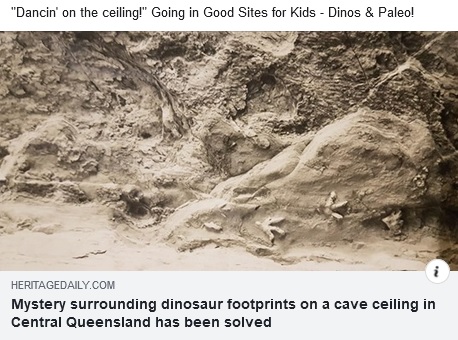
...after more than a half a century. Australia had
dinosaurs out the yang.
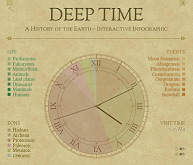 Deep
Time is a well done HTML5 interactive infographic in the form of a pie
chart/clock face. The aim is to give learners a visual grasp of just how very
old the Earth is.
Deep
Time is a well done HTML5 interactive infographic in the form of a pie
chart/clock face. The aim is to give learners a visual grasp of just how very
old the Earth is.
"The Earth is old; very, very old. It is difficult for us humans to fully
comprehend just how old our planet actually is. This infographic offers a
visual way to explore the various stages of the Earth's history using a 12
hour clock analogy."
Examine the progression and changes over time of Life, Eons, and Events. The
Features section has recommended settings for various devices, more about
the clock, and short explanations for the three sections. Also, hovering over
the various links that flank the clock face shows small graphics for each
link, located according to their time on the 12 hour clock.
DinoDictionary "Dinosaurs from A-Z! DinoDictionary.com is your resource for hunting dinosaurs. With profiles of over 300 known dinosaurs, immerse yourself in a wealth of knowledge about the giants that roamed the earth so long ago!" We had this on our site at one time, but it somehow escaped! It's back here now - same great resource as before.
Dino Directory The Natural History Museum located in London, UK, brings us this great new dinosaur site. "This is a guide to 331 of the most well-described dinosaurs, including 1301 images." They have an A - Z dino listing, a good explanation of dinos and other ancient reptiles, a timeline of which dinos lived when, a body shape guide, what dinos lived in your country, and a listing of where and when they lived, complete with world maps! An amazing amount of data and the pictures are good, too.
Dinosaur Pictures
and Facts 1,365 different species
of dinosaurs, listed alphabetically, with plenty of pictures.
"Welcome to the internet's largest dinosaur database.
Check out a random dinosaur, search for one below, or look
at our interactive globe of ancient Earth!
Whether you are a kid, student, or teacher, you'll find a rich
set of dinosaur names, pictures, and facts here. This site is
built with PaleoDB, a scientific database assembled by hundreds
of paleontologists over the past two decades.
DinosaurPictures.org curates high quality, realistic illustrations
of dinosaurs and other ancient creatures. All credit for images
goes to the original authors and creators. If you would like to
add a picture, (please email us or use this form)."
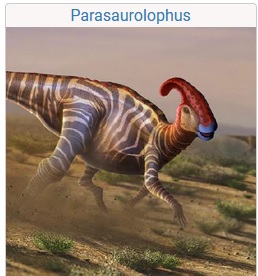
Dinosaur Footprint Identification Chart Posted on @Imgur by @DinoDork54
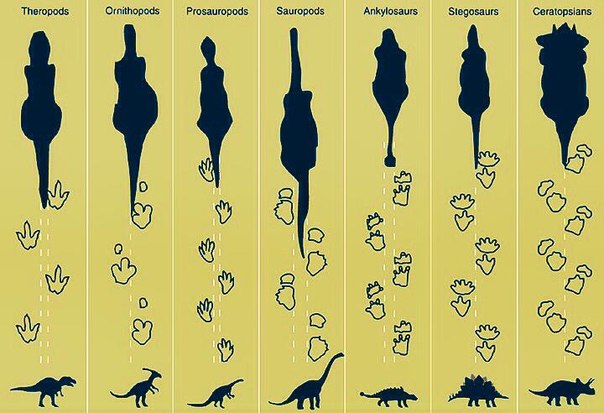
Dino Quiz from the Natural History Museum has 10 questions to find out what kids know about dinosaurs. Test yourself and see.
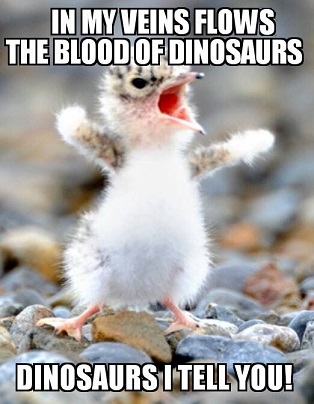
Dinosaur Art Lots and lots of dinosaur pictures!
Dinosaur coloring Print out and color these dino coloring pages from Ivy's Coloring Pages.
Dinosaur Defender Flash game from the Natural History Museum. Use your mighty tail club to defend baby dinosaurs from raptors!
Dinosaur Dig from the San Diego Natural History Museum. "Dig into dinosaur data. Find out about finding fossils. Ponder the link between meteors and mass extinction. Discover how, where, and what you need to know about finding fossils. Dig up dinosaur data, find out what is and isn't a dinosaur. Match dinosaurs and prehistoric reptiles with their scientific names. " More activities and links, too.
Dinosaur Extinction Tells what may have caused dinosaurs to go extinct, with animation and poetry.
 Dinosaur
Fact "Welcome
to Dinosaur Fact. This is the largest compilation of knowledge in relation
to everything to do with dinosaurs." Let's see, they have 4,000,000,000
years' worth of well-explained Timelines (Eras and Eons). They have pages
and pages about dinosaurs, pterosaurs, and marine reptiles of all three periods
(Triassic, Jurassic, Cretaceous). Dino groups, extinction theories, and Canadian
dinos. They have dinosaur games, jokes, wallpapers, FAQ, dinosaur sounds (what
they might've sounded like), and "Dino stuff for sale". [;tldr -
It's well done, cool, worth exploring!]
Dinosaur
Fact "Welcome
to Dinosaur Fact. This is the largest compilation of knowledge in relation
to everything to do with dinosaurs." Let's see, they have 4,000,000,000
years' worth of well-explained Timelines (Eras and Eons). They have pages
and pages about dinosaurs, pterosaurs, and marine reptiles of all three periods
(Triassic, Jurassic, Cretaceous). Dino groups, extinction theories, and Canadian
dinos. They have dinosaur games, jokes, wallpapers, FAQ, dinosaur sounds (what
they might've sounded like), and "Dino stuff for sale". [;tldr -
It's well done, cool, worth exploring!]
Dinosaur Fun "Learn all about dinosaurs in our Dinosaurs section! Play games, print and color dinosaur coloring pages, and learn lots of cool facts about these amazing creatures."
Dinosaur Games from Kaboose. Several dinosaur-themed games and activities.
"Where
paleontology meets pop culture" Hundreds of pages of Dinosaur articles!
Several stories on each page, with plenty of illustrations and dino art! Something
for elementary through adult. Good discussions and explanations of what you're
seeing. If something new about dinosaurs hits the press, it's in here. Part
of the Smithsonian Institution's gargantuan site.
Dinosaur
World This new site features good pictures and information
about the Tyrannosaur family, Feathered Dinosaurs, and Weird Dinosaurs.
Click on the names on the left side of the page to learn about individual dinosaur
species.
Dinosauria Online has
everything you ever wanted to know about dinos.
Kids mostly just head for the huge art gallery!
The Dinosaurs "Everything
kids need to know about Dinosaurs!"
News, games, interesting people, plus data on dinosaurs!
Dinosaurs
Size Comparison 3D
3d Animation Size comparison
40 minutes of people walking past
dinosaurs. The dinosaurs get
bigger as the millions of years
roll by!
Dr. Mary H. Schweitzer, Phd "It's a girl and she's pregnant," Dr. Schweitzer said to her lab assistant, Jennifer Wittmeyer. These two researchers used ingenious lab techniques to discover soft tissue in T-Rex fossils. At a presentation at the Black Hills Institute in 2005, we were in the audience watching spellbound as Dr. Schweitzer gently pulled and stretched 68,000,000 year old collagen tissue from medullary bone in an ovulating T-Rex's femur!
From Wikipedia: "Schweitzer was the first researcher to identify and isolate soft tissues from a 68 million year old fossil bone. The soft tissues are collagen, a connective protein."
From Smithsonian: "Before female birds start to lay eggs, they form a calcium-rich structure called medullary bone on the inside of their leg and other bones; they draw on it during the breeding season to make eggshells. Schweitzer had studied birds, so she knew about medullary bone, and that’s what she figured she was seeing in that T. rex specimen."
An NSF article stated in part: "Schweitzer found that the dinosaur tissue was virtually identical to that of the modern birds in form, location and distribution. Removal of the bones' minerals revealed that medullary bone from the ostrich and emu was virtually identical in structure, orientation and even color, with that of the T. rex."
This shows (1) there is still a lot to learn about fossilization and (2) yet more evidence (if you needed any more) that birds ARE dinosaurs. And that leg bone is still 68 million years old, soft tissue and all.
![]() Download
a Dinosaur lets you download templates for making paper dinosaurs!
Download
a Dinosaur lets you download templates for making paper dinosaurs!
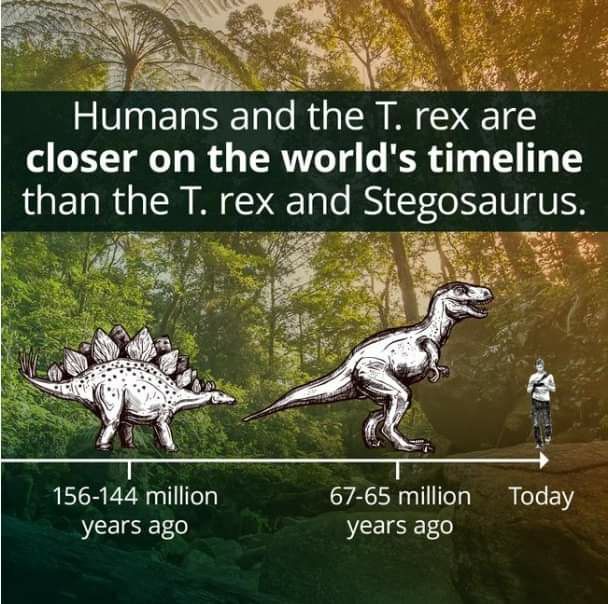
The
Dromaeosauridae The “raptors”
Dromaeosaurid Hunting Behaviour Illustration by Luis Rey
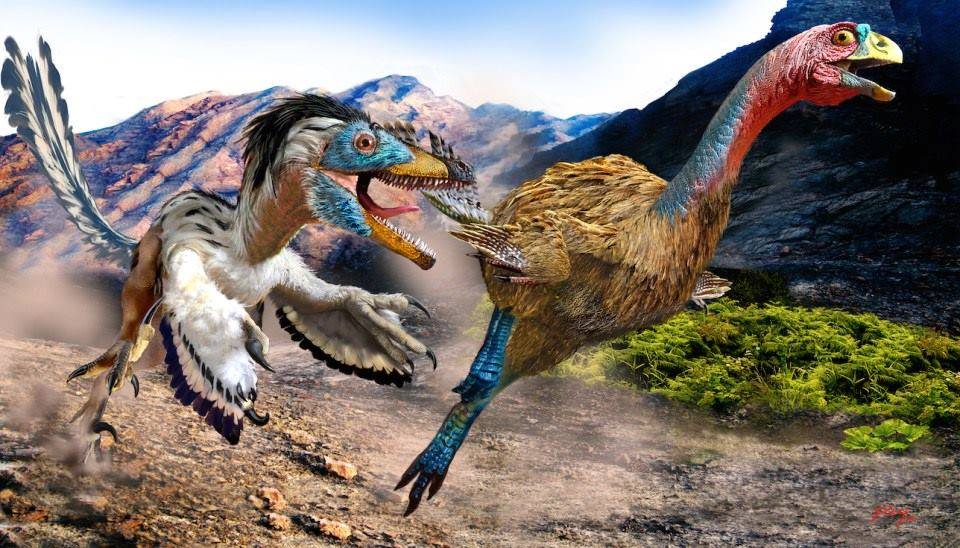
Dueling Dinosaurs This is not your classic dinosaur site. It's an online advert, BUT..."this exciting find consists of two of the most complete dinosaur skeletons ever found in the Hell Creek Formation", seem to have died fighting each other! Videos show the excavation, fossil prep, artwork, and a great 3-D model you can move around! Includes links to articles on both dino species involved. Was Nanotyrannus just a young T-Rex? This one bit off more than it could chew, so to speak.
EarthViewer "is a free iPad app that takes you through 4.5 billion years on Earth. EarthViewer allows you to select eons and eras to view. Within each eon and era you can view tectonic plates, continental drift, and other geological events. You can view major biological events in EarthViewer too. Climate data for the last one hundred years is available in the app. EarthViewer users can manipulate the virtual globe to see how each continent has moved and been altered over time." Credit = http://ipadapps4school.com/
Elephant Odyssey Be a baby mammoth! "On this journey through time, you'll learn the ways of mammoths and their modern day descendants, the elephants. - So let's go back 200,000 years and test your skills." Mother Mammoth trains you in the basic skills, including keyboard commands. You get three lives. Good luck! From the San Diego Zoo's new Elephant Odyssey exhibit.
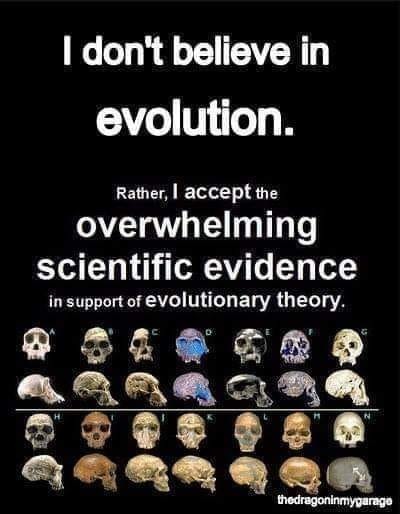
Evolutionary Anachronisms - the concept that one member of a symbiotic partnership goes extinct, and the other member must adapt. This is being used to explain weird fruits and odd seeds that no modern animal can eat. The idea is the animals that once ate them, and scattered their seeds, are no more. Here are five sites that try to explain the idea:
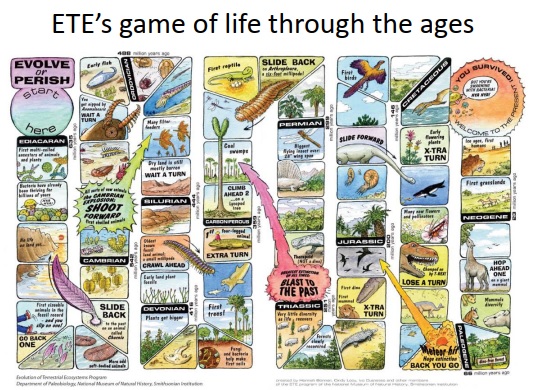
"This
is a board game developed by artist-illustrator
Hannah Bonner and the
Evolution of Terrestrial Ecosystems Program,
Smithsonian Institution. The set-up is similar to
Chutes and Ladders (in Europe, Snakes and Ladders)
- you use chips and a die to reach the finish.
Evolve or Perish, however, also takes you through
630 million years of evolution from life in the sea
to life on land! The guidebook explains all the
organisms and events in more detail and supports
learning about the history of life on our planet.
The game can be played at two levels; beginner
and advanced."
2-4 players, 15 to 30 minutes
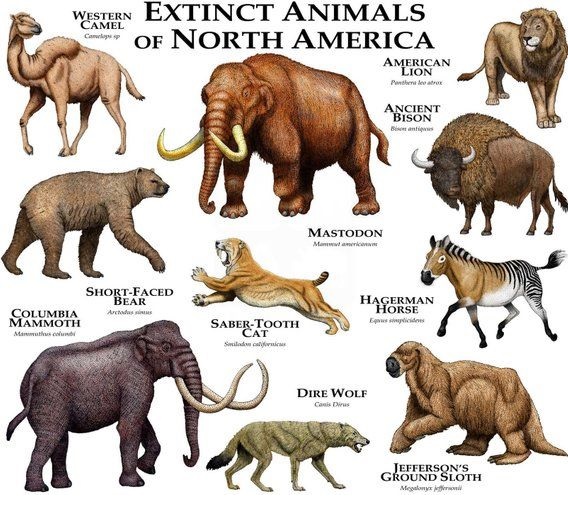
![]()
Fly
Over World's Longest Continuous Dinosaur
Tracks
In Spectacular New Drone Footage
Article by Holly Large, IFLScience
Supercool drone footage is in this
article, click on it to see the Youtube
video (1:24) with closeups of the
huge footprints that a big sauropod
laid down in the late Jurassic
era,
150 million years ago. Big, deep
footprints made in mud, and they
look fresh! This is a reminder that
Earth is very old and things change,
and dinosaurs were real.
The Geologic
History of Earth. Note the timescales. We are currently in the Holocene,
which has been
warm and moist and a great time to grow human civilization. But the activity
of civilization is now
pushing the planet into a scary new epoch which scientists call the Anthropocene.
Source: Climate Change And The Astrobiology Of The Anthropocene at NPR by
Adam Frank.
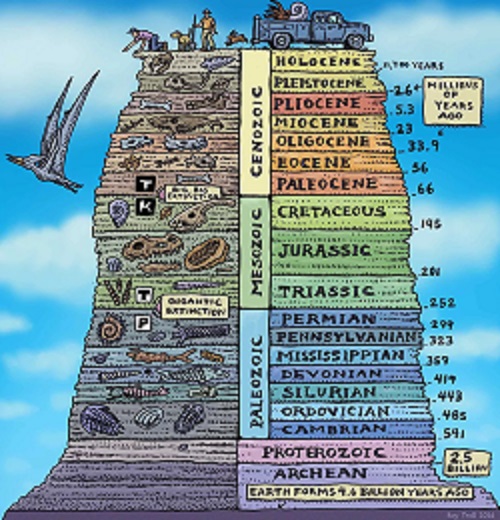
Click on this graphic to see it at its HUGE size!
Then find the Jackalope!
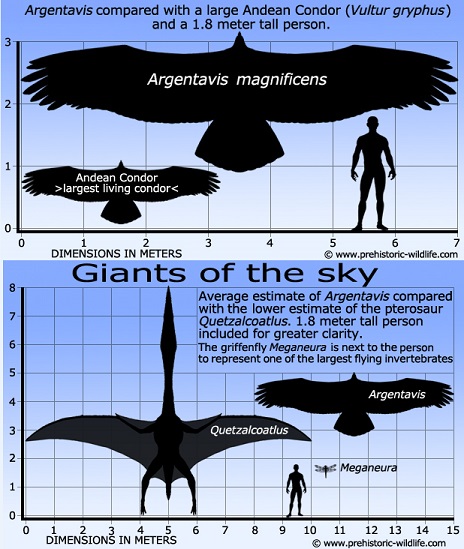

Giant winged Transylvanian predators could have eaten dinosaurs "Welcome to the Cretaceous Romanian island of Hateg, once populated by lifeforms stranger than anything imagined by Lovecraft or Giger." Meet the azhdarchids, giant pterosaur predators of the Cretaceous. "Pterosaurs were an incredibly successful group, thriving globally for 170 million years." The article also compares the four types of fliers: insects, pterosaurs, birds, and bats.
%20%20Arambourgiania%20(centre)%20and%20Hatzegopteryx%20(right)..jpg) A
giraffe and human provide scale for the pterosaurs Arambourgiania (centre)
and Hatzegopteryx (right).
A
giraffe and human provide scale for the pterosaurs Arambourgiania (centre)
and Hatzegopteryx (right).
Gone
Fishing game from the Natural History Museum.
"Use your enormous Baryonyx hand claw to hook fish
out of the water. Be quick if you don't want to starve!"
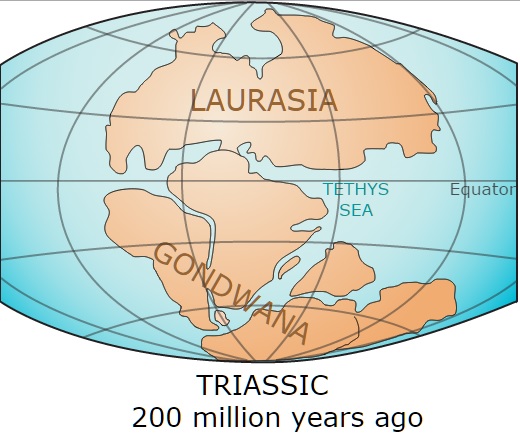
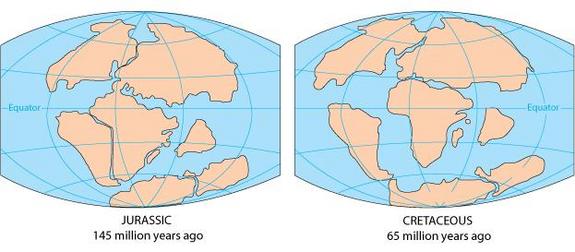
![]() from UCMP Berkeley. "Those hairy, milk-producing, warm-blooded animals
that you have seen all of your life are mammals." The site features comprehensive
information on the four groups of mammals:
from UCMP Berkeley. "Those hairy, milk-producing, warm-blooded animals
that you have seen all of your life are mammals." The site features comprehensive
information on the four groups of mammals:
You can read more about "multis" here. Read about the Paleocene mammals of 65 - 55 million years ago, too.
History of life on Earth from the BBC. Their usual informative and creative treatment, this time in the form of an interactive timeline that keeps expanding, and again, and so on, and so on... The first timeline starts at 4.6 billion years ago and stops at 0.2 million years ago. To maintain a semblance of scale you can magnify the last 600 million years to make another time scale, and then another for last 250 million years. (This scheme was well thought out! The last timeline stops at the end of the last ice age. Scrolling down from the timelines, you find Geological time periods.This covers 19 eras from 3.8 billion years ago to the present time. Click on the thumbnail for any era and you'll be drawn into a wealth of cool facts, pix, and information! Go down the page and there are more thumbnails - colorful sections about the Big Five mass extinction events, Mass extinction theories, and Ancient Earth habitats. If you do it all at once, your eyes'll be glazed! Tons of information to supplement your textbook, to use for a report, or just to wonder at the awesomeness of deep time.
Ichthyosaurs. This is a great big multiple-page site that is packed with information! From two to 16' (61cm to 4.9m) long, with 10" (2.54cm) eyes, diving to perhaps 2,000' (609m), these "fish lizards" sometimes got the bends as the hunted in deep dark water. Find out much more at this big site. Lastly, find out about their weird fins reinforced by a fiberglass-like mesh!
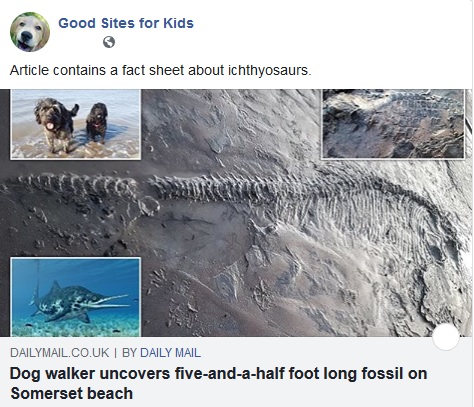
Article contains a good fact sheet about ichthyosaurs.
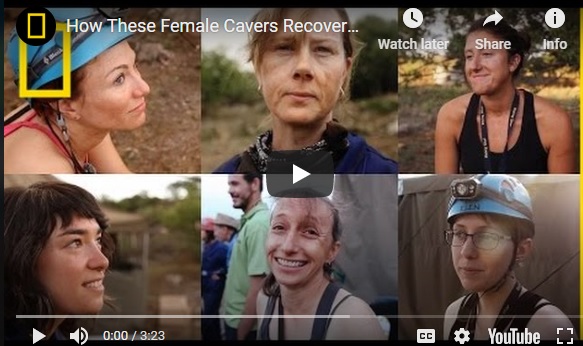
How These Female Cavers
Recovered New Human Ancestor Fossils
Deep within a cave in South Africa, more than 1,200 individual bones of a
new
human ancestor, Homo naledi, were discovered. To recover the bones, six
archaeologists had to rappel down underground shafts and squeeze through
rocky passageways as narrow as 18 centimeters (8 in). The call went out and
all the small, tough, limber athletes who qualified - were women.
 Jason's Dinosaur Site is back,
after all these years! Still colorful,
Jason's Dinosaur Site is back,
after all these years! Still colorful,
loud, and entertaining!
A new generation of kids will love it just like always.
Kids Dinos from KidsKnowIt. One of the best dino sites Lots of data, activities, and games about dinosaurs.
Koolasuchus was a giant Australian carnivorous amphibian from the Cretaceous, 120 million years ago. Everyone thought this type of amphibian died out at the end of the Permian, 220 million years ago. Yet there were still some in southern Victoria 100 million years later. In this video (3 mins) from the Melbourne Museum, the two discoverers describe their roles in finding and preparing the fossil. The illustration at left is by the Australian artist dewlap on deviantart. (We think it's great!) Click on the picture to see the full-size version.
![]()
The first frogs, the oldest known frogs:
Czatkobatrachus from Poland and...
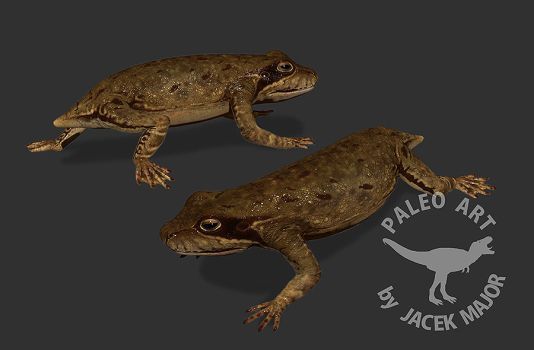
Triadobatrachus from Madagascascar
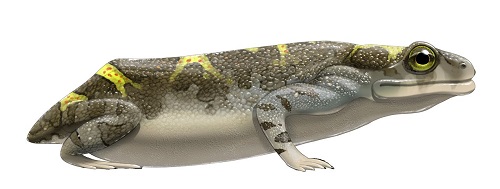
Both are from the early
Triassic era, 250 million years ago.
They could not jump because they did not have the proper
hips and the long back legs, but they were getting there.
Real frogs and toads were coming!
![]()
Learning
Zone
Welcome
to the Learning Zone
"Created by the Oxford University Museum of Natural History,
this site teaches you all about the natural world.
It's designed for kids and teachers to offer information, resources,
and activities on topics including fossils, rocks, and living things."
The site is organized by subjects and by age level. Rather than
list what is listed on their pages, we encourage you to visit them.
Located in the small but lively town of Hot Springs
in the southern Black Hills, the Mammoth Site is
an ancient sinkhole full of dozens of mammoth
skeletons! Click on the menu bar along the top
to take the Virtual Tour and check out their
Education Department.
Marching
Dinosaurs - Animated Size Comparison
6:56 video shows awesome march of real dinosaurs
of ever increasing size, set to music.
Mawsonia,
a prehistoric coelacanth from the Cretaceous Period of Africa and South America,
compared with 1.8 meter tall person.
Credit = Artwork by @Hyrotrioskjan published on DeviantART.
This graphic and text via Prehistoric
Life in the Phanerozoic Eon's Facebook page.
Juuuust a little larger than modern coelacanths.
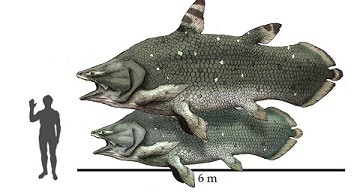
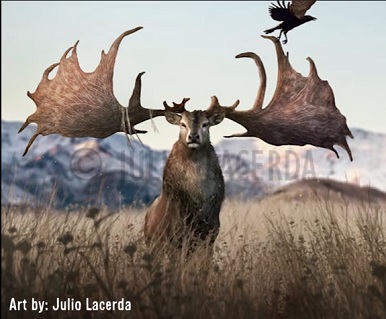
Megaloceros
- The Grand Deer
"Megaloceros is one of many remarkable megafauna
that inhabited earth during the last ice age, with
its giant, awe-inspiring antlers as its main source
of fame. I hope you enjoy!" Biggest deer ever!
A 10:53 Youtube video from Henry the PaleoGuy
explains it all.
When Giant Deer Roamed
Eurasia
7:05 video from the PBS Eons series.
Megaloceros was one of the largest members of the
deer family ever to walk the Earth. The archaeological
record is full of evidence that our ancestors lived
alongside and interacted with these giant mammals
for millennia. But what happened when they did
interact, when humans met this megafauna?
Megaloceros (Irish Elk) in a rotary
gallop
A 29-second Vimeo short by Reid Psaltis shows
how these giant deer galloped.
Museum of Geology, SDSM&T (South Dakota School of Mines and Technology). This great science and engineering school (one of the world's best) has their world-class collection of fossils and minerals online! Their unique Dino Cam lets your watch one of best mosasaur skeletons anywhere while it and a nearby plesiosaur check out the horns on a Columbian mammoth! (Not your normal scenario.) Read the brag about their thousands of specimens on exhibit!
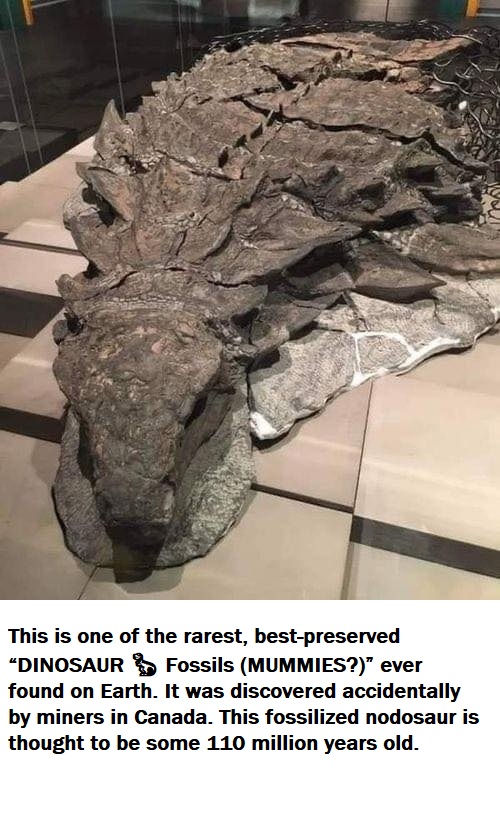
Ology from the American Museum of Natural History. We love this site! It covers "Ologies" such as Archaeology, Astronomy, Biodiversity, Earth, Einstein, Genetics, Marine Biology, Paleontology, and Water. The bottom half of the page has links to around 20 activities, experiments, and interviews. Then there's the Highlights section, Ask a Scientist, an Advanced section, and At the Museum. Click on the blue buttons in the At the Museum box. Only part of this great site is shown at a time. Be sure to use the Search box and enter a term like "horse" to find a ton of other information.
OZ Fossils, The Age of Reptiles The dinosaurs of Australia brought to you by ABC - the Australian Broadcasting Corporation. This "good site" covers the the dinos and sea beasts of Mesozoic Australia's three different regions. Also discussed are continental drift - Australian style, and the climate, plants, and animals. There are some decent games as well.
Paleoart
Gallery
of Theropoda, an Italian paleontologist's
blog. A small gallery of beautiful dinosaurs, many with their feathers. The
rest of the site is highly technical and in Italian. Grazie, Andrea Cau. Going
in Dinosaurs and Paleontology.
Geology of the world and the Environment
Palo Duro Canyon, Texas, USA
Palo Duro Canyon is a canyon system of the Caprock Escarpment
located in the Texas Panhandle near the cities of Amarillo and Canyon.
It's the second-largest canyon in the United States at 120 miles long,
as much as 20 miles wide, and has a maximum depth of more than
800 feet. Its elevation at the rim is 3,500 feet above sea level.
Palo Duro Canyon was formed by water erosion from the Prairie
Dog Town Fork of the Red River. The water deepens the canyon
by moving sediment downstream. Wind and water erosion gradually
widen the canyon. Most of the strata visible in the Canyon were
deposited during the Permian and Triassic periods.
To see information about the formations, click here
and
then scroll down.
Paleontology Portal A joint effort of several museums and professional paleo organizations, this GREAT portal lets you explore the world through geological eras; every kind of fossil imaginable through every era of time; shows you great places to visit that are paleontology hot spots; and has a nice collection of resources and links! Go there and be amazed. Great for school projects and research, too.
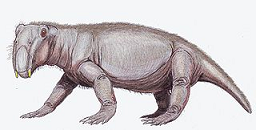 Permian
Monsters: Life before the Dinosaurs This lavishly illustrated pdf guide
introduces the Permian (290 - 250 million years ago) . Learn about The Continent
- Pangea. The Sea - Panthalassa, teeming with a huge variety of strange looking
life. Turtle ancestors with no shells, ancestors of mammals and dinosaurs
side by side, giant predator amphibians, and the Great Dying at the end.
Permian
Monsters: Life before the Dinosaurs This lavishly illustrated pdf guide
introduces the Permian (290 - 250 million years ago) . Learn about The Continent
- Pangea. The Sea - Panthalassa, teeming with a huge variety of strange looking
life. Turtle ancestors with no shells, ancestors of mammals and dinosaurs
side by side, giant predator amphibians, and the Great Dying at the end.
But wait, there's more!
Interactive games -
Six games: Word Finder (3 levels), a Quiz on the Permian, colouring, Hangman
(don't break the fossil), a matching game (easy), and a jigsaw puzzle.
Adventure
Guide - pdf file, essentially one big quiz, it could be useful for assessment.
AWWWRK! BRUNO WANNA STEAK!
Ancient parrot
in New Zealand was 1m tall, study says
Planet Dinosaur from the BBC has replaced the late Big Al Game. This worthy successor has more to do yet is easier. Fine graphics, good playability, good sounds and music. "Rediscover the lost world of the dinosaurs - from the monstrous Spinosaur to the majestic Paralititan in the all new game. Play your very own Dinosaur Planet. Will your world survive?"
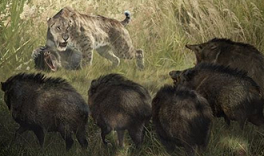 Rescue
Party from Prehistoric
Life in the Phanerozoic Eon
Rescue
Party from Prehistoric
Life in the Phanerozoic Eon
"Rescue Party - A starved Smilodon gracilis is hesitant in protecting
its prey in front of decisively approaching pack of Platygonus peccaries.
Platygonus has been found around Smilodon gracilis, but seems it was
rarely its prey. The reconstruction gives a possible explanation.
Pleistocene of Florida. *Artwork and description by @Velizar Simeonovski."
From Argentina: Newly discovered dinosaur (purple) size and
weight comparisons.
(In your dreams, Barnie!)
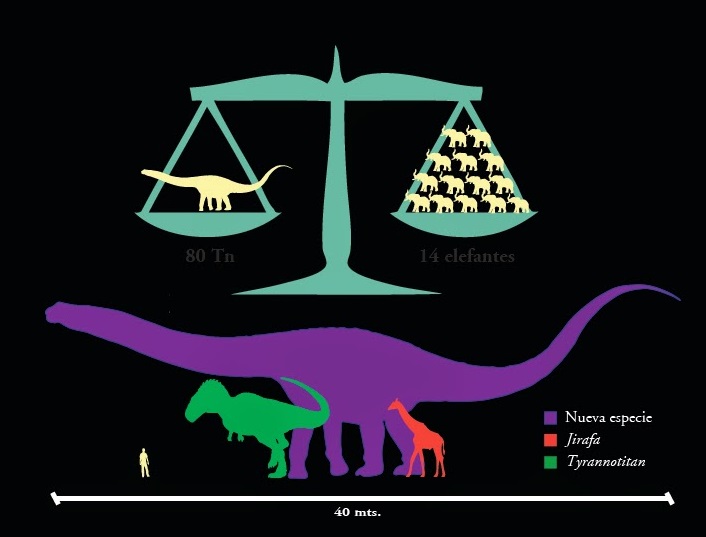
Sea Monster Facts "Sea Monsters" are the big sea creatures, from giant scorpions and sharks to sea reptiles and primitive whales, that lived in the oceans through time.
Sea Monster Game AWESOME! (click on Open in the picture) Learn while you try to stay alive! Smart learners will want to go through Sea Monster Facts first.
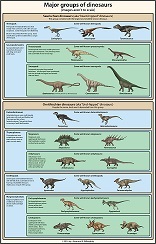 A
simple guide to dinosaur classification by Agahnim on deviantART. "This
image is a collaboration between me and EWilloughby. She and I recently noticed
that a lot of people seemed confused about the distinctions between various
groups of dinosaurs, so we created this as a simple guide to it... at least
95% of dinosaurs, and all of the best-known dinosaurs, fit into one of these
groups. A
poster of this chart is for sale at Zazzle." This is a very informative
and easy to read infographic. If you find yourself going to this link often,
please do the right thing and order the poster.
A
simple guide to dinosaur classification by Agahnim on deviantART. "This
image is a collaboration between me and EWilloughby. She and I recently noticed
that a lot of people seemed confused about the distinctions between various
groups of dinosaurs, so we created this as a simple guide to it... at least
95% of dinosaurs, and all of the best-known dinosaurs, fit into one of these
groups. A
poster of this chart is for sale at Zazzle." This is a very informative
and easy to read infographic. If you find yourself going to this link often,
please do the right thing and order the poster.
Skrat
actually lived! Scientific name Cronopio dentiacutus, it
was a member of the extinct superorder Dryolestoidea,
the ancestors of both modern-day marsupials and placental mammals. Skrat lived
100 million years ago (MYA).
Read the
Ars Technica article to learn more.
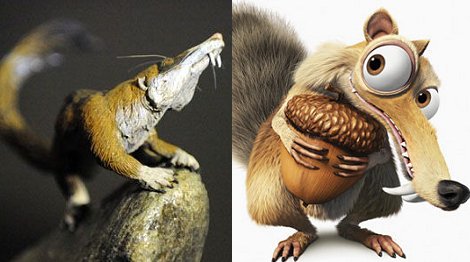
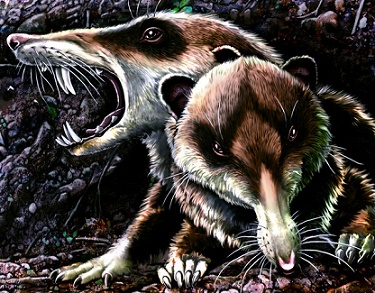
![]() Steller’s
Sea Cow from New Dinosaurs
Steller’s
Sea Cow from New Dinosaurs
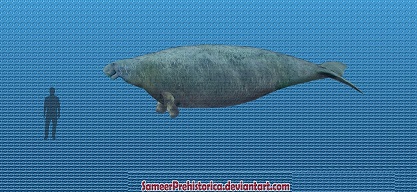
A giant relative of dugongs
and manatees, these peaceful
giants lived in the northwest Pacific for two million years.
More distant relatives are the elephants and the hyraxes.
Steller's Sea Cows ate kelp and plenty of it. They were very
tame and harmless, except to kelp. They were huge - bigger
then orcas and much heavier. They were discovered by European
explorers in 1741 and hunted - until they became extinct in only
27 years (1768) . A sad ending for these ancient, unique animals.
![]()
STROMATOLITES: Discovering the Oldest Fossils on Earth | CGI Documentary
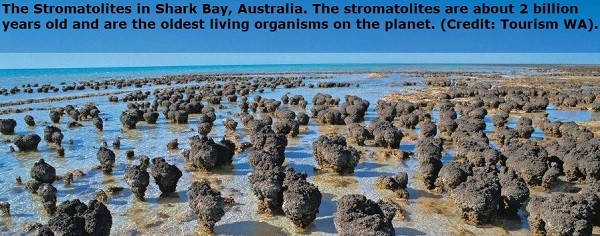
13 minute video, explans all about stromatolites. Scientiic jargon may
have to translated for kids. It is worth it. These thngs made oxygen we
breathe. They go back over 3.5 billion years.
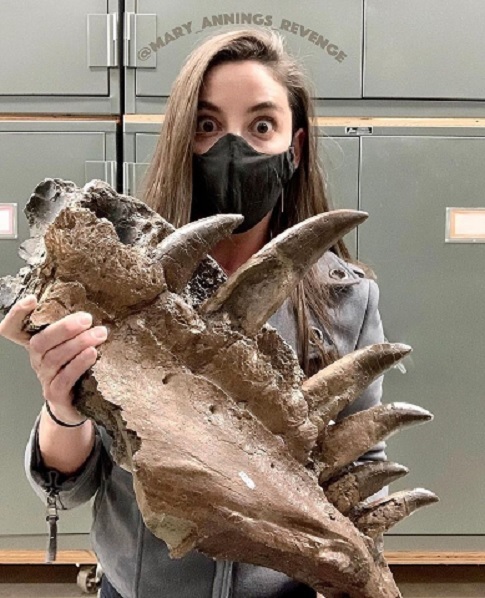
Amy Atwater, paleontologist, holding a T. rex jaw.
This is the upper jaw bone, full of huge, serrated
Tyrannosaurus rex teeth. These teeth are robust and
wide, not flat like a knife. This allowed T. rex to bite
through flesh and bone. This is a plaster cast of the
real jaw. She couldn't lift the real jawbone.
Trilobites,
like the ones fossilized here, emerged more than 500 million
years ago in what’s called “the Cambrian explosion,” a period
when large numbers
of novel species with skeletons, eyes and limbs evolved with remarkable
suddenness. Trilobites are so called because of the three parts, or lobes,
of
their bodies. From Morocco. Credit : Andrew A. Sicree #GeologyHere #Fossil
From Geology of the World and the Environment, on Facebook.
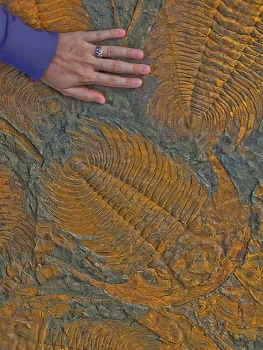
Beautiful fossil of a trilobite from 420 - 430 million years
ago. Way before Dinosaurs existed.
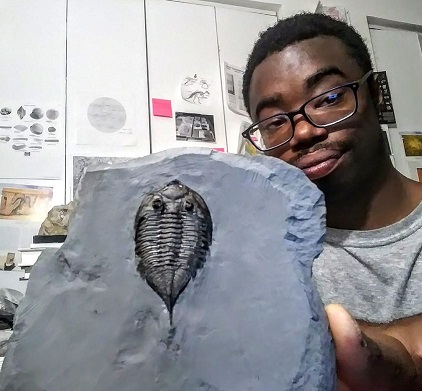
"Here is the Phacopid trilobite Dalmanites limulurus from
the Lower Silurian (Wenlockian) Rochester Shale of
Caleb's Quarry, In Middleport, New York state."
![]()
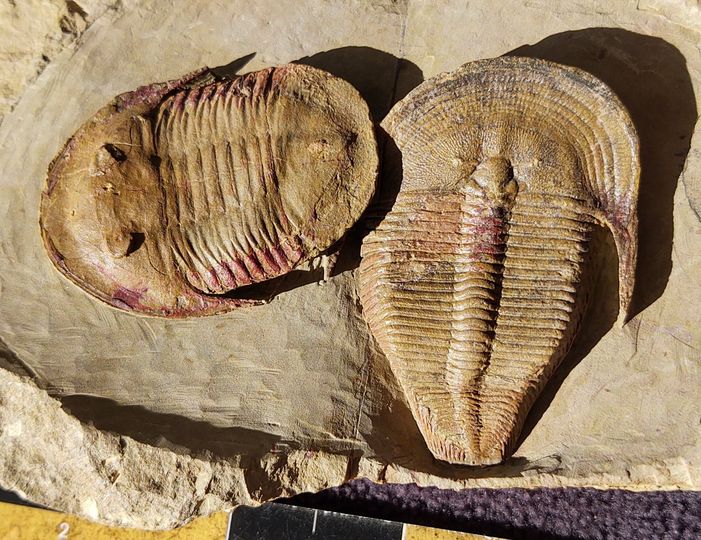
A beautiful Harpides sp. and Asaphellus trilobite multiple
from the Ordovician of Zagora, Morocco.
Via @George Walter Ast
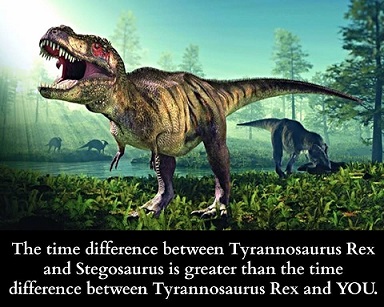
T. rex died out 65 million years ago. Stegosaurus last walked the Earth
150 million years ago, meaning they were separated by 85 million years.
Time is very deep. (Graphic & information from IFLS)
They used Science (COMIC) from ScienceDump "This is a comic drawn by ZenPencils. The quote is from Phil Plait taken from a talk he gave at a student science fair. Apparently, the night before the speech Phil didn’t know what he was going to say, until he saw a news story, full of the normal psuedo-science stuff they so often are. He then wrote this speech. One thing is for certain, the speech (and the comic) will help reinvigorate your love of science."
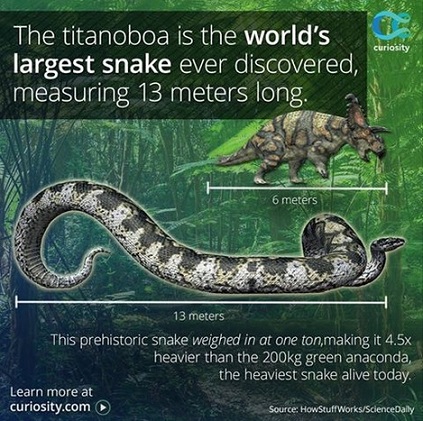
Utah's Dinosaur Record from the Utah Geologic Survey. (check out the whole site or buy posters at this link) Utah has a LOT of dinosaurs to be proud of. This pdf graphic of Utah's dinosaur history shows the eras/ages that make up the Mesozoic Era, and aligns them with local formations. From the Upper ("late") Triassic to the end of the Cretaceous, all known Utah dinos and their artifacts are listed by their place in time. Great for education, since it gives a sense of scale as to how long the dinosaurs were around!* This is an excellent graphic!
*You could also take elementary kids out on a football field and have them step it off.
Virtual Dinosaur Dig from the Smithsonian Institution's National Museum of Natural History, Department of Paleobiology. This is an interactive, virtual activity. Find a virtual fossil, virtually excavate same. Then learn about its anatomy, what it ate, and the environment it lived in. You can also see what it might have looked like when it was alive.
Walking with Beasts from the BBC, but hosted on the Australian ABC site. Very good site covers the history of prehistoric mammals just as Walking with Dinosaurs covered dinos. Great educational information. Fact Files cover 32 different "beasts." Changing World has good data on each of the seven eras from 65 million years ago to the present day. Mammal's Family Tree has a simple interactive cladogram, hold the mouse pointer over a name and facts appear on the lower screen area. Also has two different games sections and some downloads. Unfortunately not being updated, but then a lot of sites aren't.
Walking with Dinosaurs Kids love all the facts in this site. Good timeline right under the title logo on the index page. Meet the Dinosaurs has Fact Files for each dino that appeared in the TV series and the DVD's, plus more. Games section, too. Interactive online games, too. Not being updated any more, but so what?
![]() to the top
to the top![]()
![]() to Good Sites
to Good Sites
Powered by ![]() The World's #1 Web Host
The World's #1 Web Host
Better watch out for 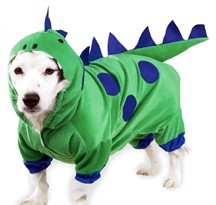 the
big bad Brittersaur!
the
big bad Brittersaur!